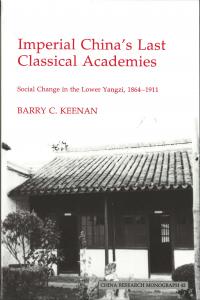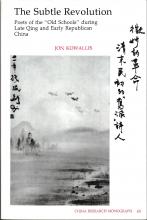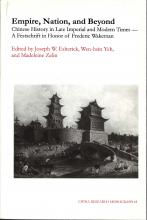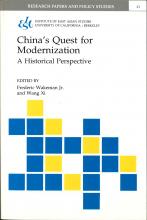Imperial China's Last Classical Academies
Imperial China's Last Classical Academies
Barry C. Keenan
Imperial China's Last Classical Academies describes the Confucian educational revival in the Yangzi Delta from the Tongzhi Restoration to the Xinhai Revolution and looks into the institutions where reform and revolution began.
As a nonprofit academic press, we need your support to publish our books. Your gift can help us make more of our titles available as e-books. DONATE NOW
Title information
Imperial China's Last Classical Academies describes the Confucian educational revival in the Yangzi Delta from the Tongzhi Restoration to the Xinhai Revolution and looks into the institutions where reform and revolution began. The revival of classical academies between 1864 and 1900 generated its own social, political, and intellectual effects that provided groundwork for all future reforms. Keenan focuses on three academies in the Lower Yangzi region: Zhongshan Academy in Jiangning (later Nanjing), Longmen Academy in Shanghai, and Nanjing ("Southern Quintessence") Academy in Jiangyin.
Barry C. Keenan
Professor Barry C. Keenan taught East Asian history for thirty-eight years at Denison University, retiring in June 2014.
B.A. Yale University, M.A. Claremont Graduate School, Ph.D. Claremont Graduate School
Imperial China’s Last Classical Academies (CRM 42)
Abbreviations – vi
Foreword – vii
Frederic Wakeman, Jr.
Acknowledgements – xi
Introduction – 1
Part I: The Post-Taiping Expansion of Formal Education in Jiangsu, 1864‑1900 – 7
1. Post-Taiping Academics and Public Charitable Schools in the Lower Yangzi – 9
Part II: Three Classical Academies, 1865-1895 – 29
2. The Governor-general’s Academy – 31
3. A Flagship Restoration Academy for Shanghai – 48
4. The Founding of a New Provincewide Academy in 1884 – 62
Part III: The Lower Yangzi Educated Elite, 1896-1911 – 93
5. Lower Yangzi Education Transformed, 1896-1906 – 95
6. Power and Conflict: Jiangsu’s Local Educated Elite, 1906-1911 – 125
Conclusion – 141
Epilogue – 145
Glossary – 151
Bibliography – 157
Index – 185
|
JOURNAL REVIEWS |
|
"Keenan's findings and general argument on the social significance of educational developments in Jiangsu after the Taiping add very valuable evidences to themes that had been explored by previous research on that region and other provinces. The most original and useful part of his work, however, remains his careful and sensitive investigation of the inner world of late classical academies, with the vivid portrait of their dedicated masters, their ways, ethos, spirit and the lasting nostalgia which these temples of true learning left in Chinese memory. Despite its focus on social history, it is probably in the field of intellectual history that the book makes its most interesting contribution, by bringing to light the life and issues of a large but forgotten segment of classical scholarship in the age of reform and Westernization." ~Marianne Bastid, in The China Quarterly (http://www.jstor.org/stable/655673) |
|
"Barry Keenan's study of the late-nineteenth-century revival of classical Confucian academies in the Lower Yangzi region after the suppression of the Taiping Rebellion in 1864 makes a significant contribution to the developing understanding of the dynamics of social change and continuity in the final decades of imperial Chinese history....Keenan makes an important contribution in his discussion of this process, in showing how there was much greater continuity in educational management and curricular content across the divide of the 1911 Revolution than has generally been thought." ~Kenneth J. Hammond, New Mexico State University, in The Journal of Asian Studies (http://www.jstor.org/stable/2646368) |




